
Diablo Canyon
The Opportunity Cost of Shutting Down Diablo Canyon
Nearly 10 percent of all driver mileage could be powered by EVs by electricity produced by Diablo Canyon
By Edward Ring, July 27, 2019 6:26 am
The flawed policies and phony accounting that are used to present renewables as competitive need to be replaced by honest analysis.
For nearly 35 years, Diablo Canyon Nuclear Power Plant has pumped just over 2.0 gigawatts of electricity onto California’s power grid. Unlike hydroelectric power, which has good years and bad depending on rainfall, or solar and wind power which depends on sunshine and wind, Diablo Canyon’s nuclear reactors generate this electricity 24 hours per day, 365 days a year.
But Diablo Canyon’s days are numbered. In January 2018 California’s Public Utility Commission voted to shut it down. Barring legislation to countermand this decision, by 2025 Diablo Canyon will cease operations, making California a nuclear free state. Is this a good idea?
Anti-nuclear environmental groups, as reported at the time in the Los Angeles Times, “hailed the decision, which was expected after 17 months of filings and debate, but also were concerned about what type of energy sources would be used to replace Diablo’s electricity.”
Good question. Especially since environmental groups are the groups one might expect to be most concerned about “greenhouse gas,” and the only way wind and solar power can operate is by having natural gas power plants to spin into action every time the wind falters or the sun goes down.
The alternative to natural gas backup is to overbuild wind and solar farms and store the excess energy with batteries. An interesting comparison would be to see what battery storage capacity would be required to replace the power Diablo generates during off peak hours of 12 hours per day.
The following chart projects a $12 billion price tag, based on a cost of $500 million per gigawatt-hour of battery farm storage. This cost estimate relies on data from several parallel projects at the 2.0 gigawatt-hour Moss Landing energy storage facility currently under development on the Central California coast.
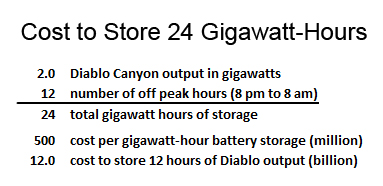
While battery storage costs are declining rapidly, with some experts projecting prices at one-fifth current levels within 10-20 years, others are not so sanguine. And battery costs aren’t the only consideration. Balance of plant costs – siting, distribution infrastructure – and California’s obstructionist construction climate will also pile on costs.
How Many EVs Could Diablo Canyon Recharge Every Night?
If Diablo isn’t shut down, of course, it isn’t necessary to invest $12 billion (or more) in battery storage to scoop up sun and wind dependent intermittent renewable energy and save it for nighttime charging. But either way, assuming California’s policymakers achieve their goal of filling our roads with battery powered vehicles, how many miles could they travel based on tapping into 12 hours of Diablo Canyon’s 2.0 gigawatt output?
As the next chart shows, the metric we’re going to be getting used to when evaluating mileage efficiency from Electric Vehicles is not “miles-per-gallon-equivalent,” but the far more descriptive kilowatt-hours per 100 miles. And based on US EPA data, most EVs on the road today require around 25 kilowatt-hours to travel 100 miles. That equates to 4 million miles per gigawatt-hour. Taking into account 12 hours of 2.0 gigawatt output from Diablo Canyon, that’s enough to power a fleet of EVs driving 96 million miles per day. How does that compare to the total mileage driven each day by Californians?
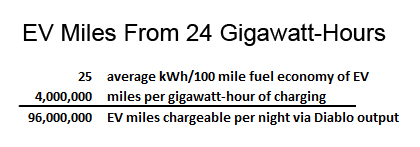
According to US Federal Highway Administration data, the Californians log per capita vehicle mileage of 9,053 miles per year. That means California’s nearly 40 million residents are driving nearly one billion miles per day. Nonetheless, Diablo Canyon alone could power enough EVs to put quite a dent into that total. Nearly 10 percent of all driver mileage could be powered by EVs charged overnight by electricity produced by Diablo Canyon.
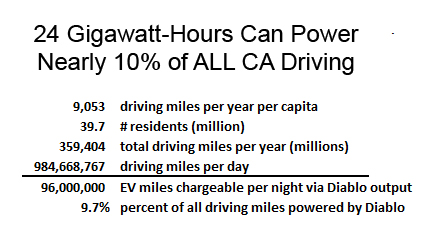
To make the opportunity cost of shutting down Diablo Canyon even more stark, one might ask what the cost would be to use solar panels and batteries to replace Diablo Canyon’s off-peak nocturnal output? The next chart shows those estimates, based on a rock bottom price of $1.00 per watt of solar panels. That is a best-case number pretty much forever, since land acquisition, engineering, labor, racking, connectors, utility interties, distribution infrastructure – along with the price of the actual panels – make this a mature industry.
As an aside, the less said about wind power, the better. Wind power is an abomination, slaughtering birds, bats, and insects at a rate which would destroy the planet in a few years if it were ever developed to any meaningful scale, not to mention the visual blight, the hideous quantities of materials, or the physical and psychological illness the inescapable low frequency thrum triggers in humans and animals.
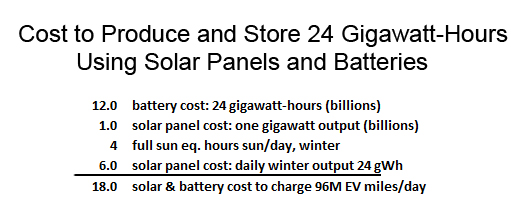
As shown above, it would cost about $18 billion to develop renewable assets using solar and battery technology to replace the overnight EV recharging capacity of Diablo Canyon. If California’s vehicles were electrified, this capacity is sufficient to power 10 percent of California’s automobile mileage. And this is exactly half the story – Diablo Canyon operates 24 hours per day, not just at night to charge EV batteries.
It is interesting – or depressing, depending on one’s ability to confront these scandalous miscarriages of policy with equanimity – to wonder why environmentalists, who think we have barely a decade to “decarbonize” before the planet is lost, are so intent on shutting down Diablo Canyon.
The only sane way to sell renewable energy is to make it cheaper than fossil fuel and nuclear power. But the flawed policies and phony accounting that are used to present renewables as competitive need to be replaced by honest analysis.
It should be obvious that if renewable energy was truly less expensive, every nation in the world would be turning to renewables instead of building, as fast as they possibly can, more coal, natural gas, and nuclear power plants.
The single most significant variable affecting the economic viability of intermittent renewable energy is storage costs. Maybe batteries will eventually come down in price to, say $50 per kilowatt-hour, i.e., $50 million per gigawatt-hour. And if and when that happens, maybe it will make economic sense to convert to 100 percent renewables. And maybe then, instead of having to sow fear and panic in the media, and weaponize brainwashed elementary school children for photo ops with politicians pushing “green” energy, states and nations will adopt renewables because they really are the cheaper alternative.
If we are entering the electric age, where not only lights, PCs, refrigerators and air conditioners use electricity, but also space heaters, water heaters, cooktops, and vehicles – not to mention cyber currency – then we’re going to need more electricity at a time when “renewables” aren’t ready for prime time. And if the urgent imperative to rush into this decarbonized electric age is to supposedly save the planet, why are we shutting down Diablo Canyon?
In the meantime, Diablo Canyon is a sunk cost. Ratepayers long ago covered the construction bill for Diablo Canyon. But these reactors, instead of continuing to generate 2.0 gigawatts of clean, carbon free electricity for decades to come, are going to be shut down and subject to expensive decommissioning costs. Those who sincerely believe in the need to decarbonize energy need to join with those who support economically sound energy policies, to demand Diablo Canyon stay open.
- Ringside: EVs and California’s Future Demand for Electricity - December 4, 2025
- Ringside: Politically Viable Water Supply Projects - November 27, 2025
- Ringside: Shifting Costs Does Not Solve California’s Electricity Shortages - November 20, 2025


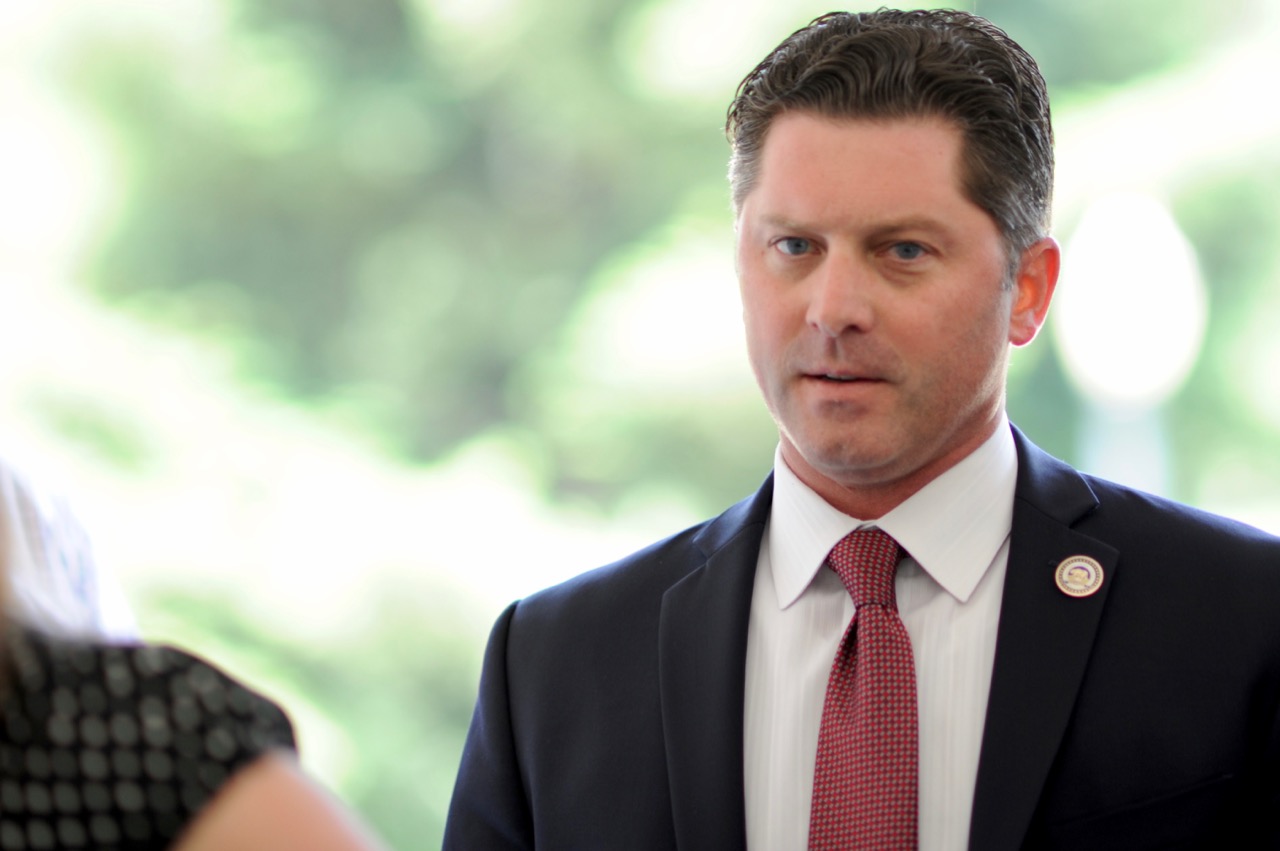


“The next chart shows those estimates, based on a rock bottom price of $1.00 per watt of solar panels.”
Edward, last week’s average cost for solar panels was $0.21/watt with a range of $0.20 to $0.30. Currently installed solar – all the hardware plus installation is about $1/watt. Single axis tracking is just over $1/watt and tracking takes the average CF to about 30% with higher CFs in the best solar sites.
The City of Los Angeles is currently processing a 25 year PPA for 400 MW AC/530 MW DC of solar electricity at a price of 1.997 cents per kWh. 100 MW/200 MWh battery storage will cost an additional 1.3 cents per kWh. And there’s an option to add 50 MW/200 MWh of energy storage for 0.665 cents per kWh more.
As for charging EVs from stored electricity. That’s not the best idea. Create charge outlets in work and school parking lots. Use EVs as a dispatchable load, charging from over supplies from solar during the day and from wind at night.
Somehow you seem to have gotten left behind.
“100 MW/200 MWh battery storage will cost an additional 1.3 cents per kWh.”
Bob,
The U.S. Energy Information Administration estimates the average cost of installed, grid-scale battery storage at $1,100/kWh:
https://www.eia.gov/analysis/studies/electricity/batterystorage/pdf/battery_storage.pdf
In other words, the price you quote for grid battery storage is 84,000 times too low.
Physicists and grid engineers have tolerated the fantasy of renewable energy for 60+ years; now, with the threat of climate change upon us, there’s no more time to waste on this foolishness. Enough is enough.
The vast majority of eclectic vehicles are chared at night. Who is going to pay for the more expensive energy for charging in the daytime?
What does it cost to operate DC? What is the impact on the utilites owners?
Sorry Mr. Ring. Pretty sure it is too late to save Diablo Canyon. The plant was issued a 40 year license from the government and that 40 years is fast approaching. If the owners wanted to extend plant life beyond those 40 years, as most US plants have done, the owners must demonstrate continued operation is safe and will remain safe. This demonstration takes a considerable amount of engineering research and review as well as adoption of additional maintenance and monitoring programs. Diablo’s owners chose to terminate those activities when the decision was made to let Diablo die at the end of 40 years.
Bob,
I do not believe solar power systems will drop in price below $1.00 per watt when you take into account not just the panels, but the labor, the cost for the site, and the balance of plant components. The data you cite supports my claim, you write “Currently installed solar – all the hardware plus installation is about $1/watt. Single axis tracking is just over $1/watt and tracking takes the average CF to about 30% with higher CFs in the best solar sites.”
Your reference to kWh pricing deserves a lengthier response which can be the topic of a subsequent article, but it addresses flow, not output capacity, so it is beside the point.
As for your point about EVs being charged in the daytime, you’re right, that is a better option, but will we really build out charging stations for millions of cars, when every home already has a built in charging capacity? And more relevant, EVs aren’t going to be the only new demand for electricity in the electric age that’ coming. What about space heating? Converting every home from natural gas to electric space heating will greatly increase demand for electricity.
I’ll stick with the original premise – if we’re going to be using more electricity in the future, and if electricity storage is still not cost effective, than we’re crazy to shut down nuclear power plants.
Wally,
I agree with you that most of the US plants have extended their operating license by following NRC Rules/requirements and Industry Programs and aging management strategies, but I would add with zero safety significant items resulting from life extension. Additionally a number of these plants are already beyond their original “40 year design life” and continue to provide safe, reliable, and clean carbon free electricity. Where I don’t agree is that it is too late to save Diablo Canyon. The LRA process does take some time to get NRC approval, but the technical adequacy of the aging management programs has been effectively demonstrated by the rest of the operating fleet. Therefore, approval of a 20 year license extension would likely only take 18-24 months, assuming that Diablo follows the recipe to the letter.
Rather than shut it down, convert it to natural gas and see how the tree huggers like that.